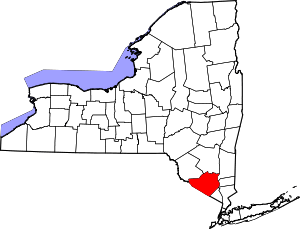Cornwall, New York
| Cornwall | |
| Town | |
 Storm King Mountain, Cornwall's best-known landmark. | |
| Name origin: from Cornwall, England | |
| Country | United States |
|---|---|
| State | New York |
| Region | Hudson Valley |
| County | Orange |
| Landmark | Storm King Mountain, Moodna Viaduct |
| River | Hudson River |
| Center | Downtown traffic circle |
| - elevation | 240 ft (73 m) |
| - coordinates | 41°26′04″N 74°02′09″W / 41.43444°N 74.03583°WCoordinates: 41°26′04″N 74°02′09″W / 41.43444°N 74.03583°W |
| Highest point | Southwest town line on Schunemunk Mountain |
| - elevation | 1,540 ft (469 m) |
| - coordinates | 41°23′52″N 74°06′39″W / 41.39778°N 74.11083°W |
| Lowest point | Sea level |
| - location | Hudson River |
| Area | 28.2 sq mi (73 km2) |
| - land | 26.8 sq mi (69 km2) |
| - water | 1.3 sq mi (3 km2) |
| Population | 12,646 (2010) |
| Founded | 1685 |
| Government | |
| - location | Town Hall |
| - elevation | 240 ft (73 m) |
| - coordinates | 41°26′20″N 74°01′42″W / 41.43889°N 74.02833°W |
| Town Supervisor | D. Kevin Quigley (R)
|
| Timezone | Eastern (EST) (UTC-5) |
| - summer (DST) | EDT (UTC-4) |
| ZIP Code | 12518 |
| Area code | 845 |
| Exchange | 534 |
| FIPS code | 36-18300 |
| GNIS feature ID | 0978869 |
 Location in Orange County and the state of New York.
| |
| Wikimedia Commons: Cornwall, New York | |
| Website: www.cornwallny.com | |
Cornwall is a town in Orange County, New York, United States. As of the 2010 census, the population was at 12,646. Located about 50 miles north of New York City on the western shore of the Hudson River, Cornwall has become a bedroom community for New York City. Commuter rail service is available via the Salisbury Mills-Cornwall train station, operated by NJ Transit, and several other nearby stations on Metro North Railroad. While the town is located less than an hour from the George Washington Bridge, major commuter routes like the New York State Thruway and the Palisades Parkway run nearby, but not through the heart of Cornwall.
Cornwall's Main Street includes a co-op, gift shops, taverns, restaurants, coffeehouses, yoga studios and boutiques. Government offices, churches, parks, the riverfront, and St. Luke's Cornwall Hospital, a part of the NewYork-Presbyterian Healthcare System, are situated within walking distance of downtown. The town is a designated Tree City.
History
When the explorer Henry Hudson visited the region in 1609 the land was occupied by the Waoraneck Indians. In 1685 a colony of twenty-five Scottish families settled around the mouth of the Moodna Creek, led by the soldier Major Patrick McGregor and his brother-in-law, David Toiseach, the laird of Monzievaird.[1][2] In the ensuing 50 years, English and Scotch families came to the fertile tableland above the river meadows naming it "new Cornwall" because of the marked similarity to the County of Cornwall, England, It is believed that the hamlet of Canterbury was the site of this settlement. The first recorded Town meeting was held here in April 1765, and here that public action was taken to change the name to Cornwall, in 1799. The late 1800s were the heyday of Cornwall's fame. It became a summer resort because of the natural beauty of the river, its mountain vistas, scenic trails, fresh country air and convenience to New York City via riverboat or railroad.[3]
The area that was to become to Town of Cornwall was part of Governor Dongan's 1685 Tract. The Precinct of Cornwall was created in 1764.[4] The Town was founded in 1788 as New Cornwall, which was changed in 1797 to Cornwall.
The nineteenth century
In the mid-19th century, Cornwall took on another personality – a health retreat. Until the early 20th century, city folk flocked to the Valley to experience the therapeutic powers they believed it to hold. The mountains, fresh air and evergreen forests were thought to offer the perfect conditions for good health and they were not far from the city. Cornwall on the west side of the Hudson became especially popular as a health retreat, offering numerous boarding houses and many conveniences of the day, including accessibility to the railroad and steamboats, as well as a telegraph office and large library. Nathaniel Parker Willis, one of the Knickerbocker writers, enjoyed the time he spent here so much he bought property in Cornwall, establishing a country home he called Idlewild. His many writings on the area helped make Cornwall a popular spot for health-seekers.
Shifting attitudes toward a more healthy lifestyle began to make the Hudson Valley popular for outdoor activities and exercise. Hiking, rowing, swimming, fishing, hunting and biking all contributed to the development in the area of summer camps as well as the notion of the summer vacation.
Historic buildings
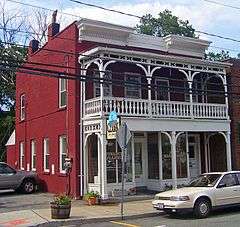
The A.J. Clark Store is located at 286 Main Street in downtown Cornwall. Archer Clark built the Italianate building to house his butcher shop around 1875, after an 1870 fire destroyed his earlier quarters. It would continue in existence in that building for a century. Later, one of his descendants converted it into a delicatessen. In 1996 it was added to the National Register of Historic Places as an intact commercial building dating from Cornwall's days as a summer resort town in the late 19th century.
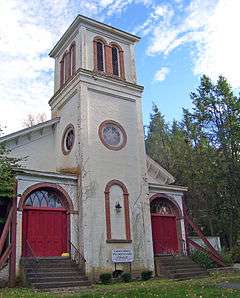
The Canterbury Presbyterian Church is located along Clinton Street in downtown Cornwall. A white stone and brick building in the Federal style, with later Colonial Revival style additions, it has been listed on the National Register of Historic Places since 1996.
The Carvey-Gatfield House is a stone house along Angola Road in Cornwall. It was built in the first decade of the 19th century in the Federal style. The land was originally the property of Isaac Bobbin, an early settler, until subdivided into the present parcel and sold to Mathias Carvey in 1805, around the time the house was built. Carvey had bought the property from William Robinson, two owners removed from Bobbin, to support his mill on a nearby stream. He in turn sold it to Benjamin Gatfield, in whose family it would remain for almost a century. It was added to the National Register of Historic Places in 1996.
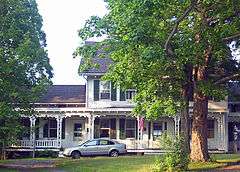
The Oliver Brewster House is a Gothic Revival home located on Willow Avenue, across from Willow Avenue Elementary School. It was originally built as a farmhouse in the mid-19th century. Later, as Cornwall became a popular summer resort for visitors from New York City, it was expanded and renovated for use as a boardinghouse as well. In 1996 it was added to the National Register of Historic Places.
The Samuel Brooks House is located on Pleasant Hill Road north of the hamlet of Mountainville. Brooks, a descendant of one of Cornwall's oldest families, built this as a farmhouse around 1860. After the Civil War, summer boarders from New York City began coming to Cornwall, and Brooks quickly adapted it for use as a boardinghouse. Its location, near Schunemunk Mountain made it a desirable location for the summer boarders who made Cornwall a popular resort community in the late 19th century. In 1996 it was listed on the National Register of Historic Places.
Notable people
- Olympic speed skater Bonnie Blair was born in Cornwall on March 18, 1964.[5]
- Rob Cohen, motion picture director and producer, was born in Cornwall on March 12, 1949.
- David Petraeus, four-star general, graduated from Cornwall Central High School in 1970.
- Whit Stillman (born John Whitney Stillman in Washington, D.C., on January 25, 1952), an Academy Award–nominated American writer-director, grew up in Cornwall.
- Shea Farrell, actor and producer noted for playing Mark Danning in the television show Hotel created by Aaron Spelling.
- Nathaniel Parker Willis was an American author and editor who is associated with notable American writers including Harriet Ann Jacobs and Edgar Allan Poe. In 1846 Willis settled on an estate bordered to the north by Moodna Creek, naming his new home Idlewild. Because of failing health he spent the remainder of his life chiefly in retirement. The site of his property has since been used for housing, with Idlewild Avenue and Idlewild Park Drive, Cornwall-on-Hudson, commemorating his choice of name.
- Actor Armand Assante,was raised in Cornwall, New York.
An environmental issue
In 1962, a 17-year legal battle began that launched modern-day environmental activism. Consolidated Edison proposed building a giant hydro-electric plant on the river at Storm King Mountain near Cornwall. Despite pressure from local residents, Con Ed went forward with its plan, applying to the Federal Power Commission for a license to operate such a facility. Three years later, after hearings and appeals and more hearings, the U. S. Court of Appeals set a major precedent when it sent the case back to the FPC to start the process over again. Its reasoning was based on the commission's refusal to hear much of the environmental impact testimony the first time around. For the first time in U.S. history, a court had decided that protection of natural resources was just as important as economic gain. It prompted Congress to pass the National Environmental Policy Act in 1969, which requires an environmental impact study on all major projects needing an OK from the federal government.

Geography
The town is located 52 miles (84 km) north of New York City, and just 5 miles (9 km) north of the United States Military Academy at West Point, in eastern Orange County. It is shaped like an irregular pentagon pointing southwards. According to the United States Census Bureau, the town has a total area of 28.2 square miles (73 km2), of which, 26.8 square miles (69 km2) of it is land and 1.3 square miles (3.4 km2) of it (4.76%) is water.
Cornwall's terrain is quite diverse, with considerable relief. It is shaped by the valleys of Moodna and Woodbury creeks, and includes estuarine salt marshes, heavily developed residential and commercial areas, rolling farms, and rocky, scrub-covered ridges and mountaintops. There are two major protected areas mostly within the town, Storm King State Park and the privately managed Black Rock Forest.

The most level section is in the northeast corner, east of the curve of US 9W, sloping gently to the river, where it borders on the towns of Fishkill and Philipstown in Dutchess and Putnam counties respectively, across the river. Here is located the village of Cornwall on Hudson, and the most developed section of the town proper, the area usually meant by Cornwall, just to the southwest of the village. To its west lies another residential area, Firthcliffe, named for the carpet factory once located here along the banks of Moodna Creek. Much of the town's population is concentrated in the village and this area.
In its south section, Cornwall on Hudson rises to the high area known as Deer Hill, a foothill to Storm King Mountain to its immediate south. South of Storm King the town's southeast boundary, with Highlands, leaves the river just north of Crow's Nest and runs through Storm King State Park, taking in most of Black Rock Forest. It turns more southerly, taking in the northwestern sliver of the United States Military Academy Reservation before reaching Cornwall's southernmost point, its tripoint with Highlands and the town and village of Woodbury.
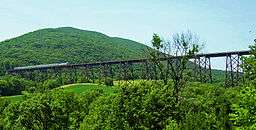
This area of town is also mountainous and rugged, with the border descending along a northwesterly line to the narrow Woodbury Creek valley, where NY 32 and the New York State Thruway enter the town. At the valley's mouth, where Woodbury Creek drains into Moodna Creek, is the small hamlet of Mountainville, with its own fire district and ZIP Code. It gets its name from Schunemunk Mountain, where the town line climbs the northern end of Schunemunk, reaching the town's highest elevation at 1,540 feet (470 m) at the tripoint with Woodbury and Blooming Grove.
Just past Schunemunk's western ridge, the town line reaches another corner and changes course to due north. This takes in the rural, rolling countryside between the mountain and Salisbury Mills, where Storm King Art Center is located and the Moodna Viaduct, the highest and longest railroad trestle east of the Mississippi River, spans the valley between Schunemunk and the Salisbury Mills-Cornwall station on the Metro-North Port Jervis Line. This trestle was shown in the 2007 film Michael Clayton and is a well known landmark. NY 94 runs through this section of town.
The town's northeast corner is another tripoint, with Blooming Grove and New Windsor, located in the middle of Beaverdam Lake. From there the New Windsor boundary runs east, trending slightly to the north, just south of the hamlet of Vails Gate back to the salt marshes where the Moodna drains into the Hudson.
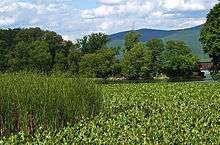
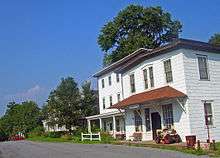
Communities and locations in Cornwall
- Beaver Dam Lake – A lake partly inside the northwest corner of the town.
- Cornwall-on-Hudson is a village in the eastern part of the town.
- Firthcliffe – A hamlet west of Cornwall on Hudson on US-9W..
- Firthcliffe Heights – A hamlet near the north town line.
- Meadowbrook – A hamlet near the town line, west of Cornwall on Hudson on NY-94.
- Mountainville – A hamlet located along NY 32 in the western part of town
- Orrs Mill – A hamlet south of Firthcliffe.
- Salisbury Mills – Part of the hamlet of Salisbury Mills is within the west town line. The hamlet is also in the Town of Blooming Grove.
- Storm King State Park – A state park by the Hudson River.
- West Cornwall – A hamlet south of Firthecliffe, by the NY State Thruway.
- Museum of the Hudson Highlands – A park and Museum eatering preserved fishes, reptiles and amphibians as well as live animals, Indian artifacts and geological specimens indigenous to the Hudson Valley. Hiking trails, interpretive and live animal exhibits, a Tall Grass Prairie and a regional artists' gallery are also found at the museum.
- The Storm King Art Center – Located in Mountainville, near Cornwall, is an art museum and outdoor sculpture park featuring the work of 20th century American and European artists. Visitors stroll the 500 acres (2.0 km2) near Storm King Mountain to view the work.
Demographics
| Historical population | |||
|---|---|---|---|
| Census | Pop. | %± | |
| 1790 | 4,225 | — | |
| 1820 | 3,920 | — | |
| 1830 | 3,486 | −11.1% | |
| 1840 | 3,925 | 12.6% | |
| 1850 | 4,471 | 13.9% | |
| 1860 | 4,800 | 7.4% | |
| 1870 | 5,989 | 24.8% | |
| 1880 | 3,833 | −36.0% | |
| 1890 | 3,766 | −1.7% | |
| 1900 | 4,258 | 13.1% | |
| 1910 | 5,690 | 33.6% | |
| 1920 | 4,259 | −25.1% | |
| 1930 | 5,067 | 19.0% | |
| 1940 | 5,299 | 4.6% | |
| 1950 | 6,154 | 16.1% | |
| 1960 | 8,094 | 31.5% | |
| 1970 | 9,672 | 19.5% | |
| 1980 | 10,774 | 11.4% | |
| 1990 | 11,270 | 4.6% | |
| 2000 | 12,307 | 9.2% | |
| 2010 | 12,646 | 2.8% | |
| Est. 2014 | 12,508 | [6] | −1.1% |
As of the census[8] of 2000, there were 12,307 people, 4,625 households, and 3,330 families residing in the town. The population density was 458.8 people per square mile (177.2/km²). There were 4,852 housing units at an average density of 180.9/sq mi (69.8/km²). The racial makeup of the town was 94.68% White, 1.32% African American, 0.16% Native American, 1.28% Asian, 0.05% Pacific Islander, 1.17% from other races, and 1.34% from two or more races. Hispanic or Latino of any race were 5.11% of the population.
There were 4,625 households out of which 36.9% had children under the age of 18 living with them, 60.2% were married couples living together, 8.7% had a female householder with no husband present, and 28.0% were non-families. 24.2% of all households were made up of individuals and 10.0% had someone living alone who was 65 years of age or older. The average household size was 2.65 and the average family size was 3.18.
In the town the population was spread out with 27.9% under the age of 18, 5.2% from 18 to 24, 29.6% from 25 to 44, 24.8% from 45 to 64, and 12.4% who were 65 years of age or older. The median age was 38 years. For every 100 females there were 92.1 males. For every 100 females age 18 and over, there were 88.7 males.
The median income for a household in the town was $72,000 and the median income for a family was $87,195. Males had a median income of $52,813 versus $37,546 for females. The per capita income for the town was $28,509. About 3.7% of families and 5.0% of the population were below the poverty line, including 7.0% of those under age 18 and 3.4% of those age 65 or over.
References
- ↑ Skeel, Adelaide, and Barclay, David, (1900), Major Patrick MacGregorie.
- ↑ Ruttenber, Edw. Manning, comp; Clark, Lewis, H., History of Orange County, Philadelphia, Everts & Peck (1881)
- ↑ Greater Cornwall Chamber of Commerce
- ↑ Eager, Esq., Sam'l W., An Outline History of Orange County, Newburgh, S.T. Callahan, 1847
- ↑ "Bonnie Blair: Biography from Answers.com". Answers.com. Archived from the original on February 21, 2010. Retrieved 2012-12-03.
- ↑ "Annual Estimates of the Resident Population for Incorporated Places: April 1, 2010 to July 1, 2014". Retrieved June 4, 2015.
- ↑ "Census of Population and Housing". Census.gov. Archived from the original on May 11, 2015. Retrieved June 4, 2015.
- ↑ "American FactFinder". United States Census Bureau. Archived from the original on 2013-09-11. Retrieved 2008-01-31.
External links
| Wikimedia Commons has media related to Cornwall, New York. |
